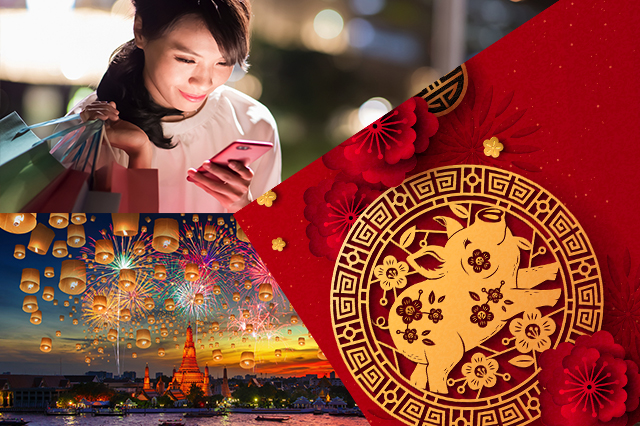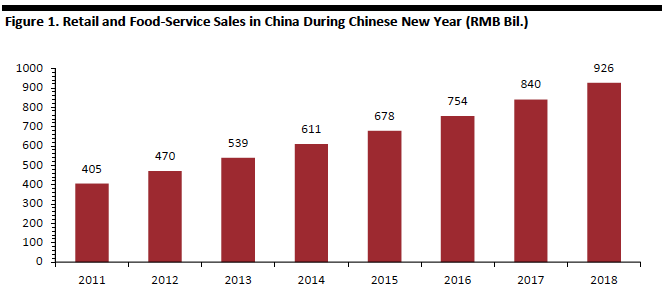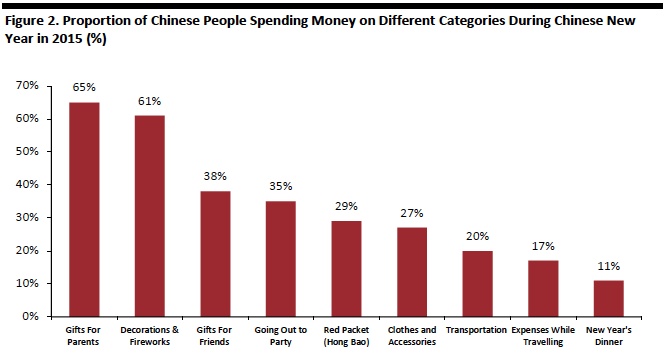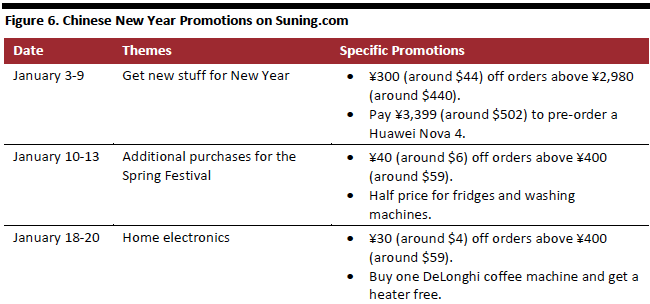
albert Chan
Retail Sales During Chinese New Year Golden Week Could Reach ¥1 Trillion
Retail and food-service sales during Chinese New Year grew steadily from 2011 to 2018. During the 2018 Chinese New Year Golden Week (February 15-21), retail sales reached ¥926 billion (about $146 billion), 10.2 % higher than the same period in 2017 —and more than double what it was in 2011, according to Ministry of Commerce statistics.
We expect New Year Golden Week retail and food-service sales to reach approximately ¥1 trillion ($158 billion) this year; that equates to a year-over-year increase of around 8%, even as overall retail sales growth is slowing.
[caption id="attachment_66493" align="aligncenter" width="662"] Source: Statista/Ministry of Commerce of the People's Republic of China[/caption]
What Do People Buy?
In the New Year period, Chinese consumers usually spend on gifts for parents and friends, including clothes, traditional New Year goods (such as gold and silver ornaments, and fireworks), organic foods, smart home appliances and new digital products. Getting together for family dinner is also big, making it a must-spend item.
[caption id="attachment_66494" align="aligncenter" width="664"]
Source: Statista/Ministry of Commerce of the People's Republic of China[/caption]
What Do People Buy?
In the New Year period, Chinese consumers usually spend on gifts for parents and friends, including clothes, traditional New Year goods (such as gold and silver ornaments, and fireworks), organic foods, smart home appliances and new digital products. Getting together for family dinner is also big, making it a must-spend item.
[caption id="attachment_66494" align="aligncenter" width="664"] Source: Statista/NetEase[/caption]
Also, because the new year is a fortuitous time to house clean to “sweep away the bad luck” gathered over the past year, sales of cleaning materials surge. In 2018, Tmall reported that sales of steam mops increased 320%, sales of dishwashers were up 188%, robotic window cleaner sales rose 169% and sales of robot chefs increased 145%, year over year, during the New Year period.
This Chinese New Year Golden Week Could See Slower Growth Due to Mild Economic Uncertainty
We have reason to be cautious in our outlook for the Chinese New Year Golden Week in 2019.
China’s official manufacturing Purchasing Managers’ Index (PMI) signalled commodity demand may not be rising, a leading indicator. The PMI was 49.4 for December 2018, according to the Chinese National Bureau of Statistics, coming in lower than the consensus estimate of 49.9 in a Reuters poll. A PMI reading above 50 signals an expanding economy, below that indicates contraction. The PMI in December 2018 was the lowest since February 2016, according to Reuters.
As the US-China trade war continues, there are signs China’s economy is slowing. The Chinese Academy of Social Sciences cut its economic growth estimate for the year from 6.5% to 6.3%.
And, these factors are combining to dampen consumer spending. Throughout 2018, China’s retail sales growth slowed: November 2018 (the latest month available), retail sales were up 8.1% year over year, down from the double-digit growth that the sector had recorded in most of 2017.
[caption id="attachment_66495" align="aligncenter" width="666"]
Source: Statista/NetEase[/caption]
Also, because the new year is a fortuitous time to house clean to “sweep away the bad luck” gathered over the past year, sales of cleaning materials surge. In 2018, Tmall reported that sales of steam mops increased 320%, sales of dishwashers were up 188%, robotic window cleaner sales rose 169% and sales of robot chefs increased 145%, year over year, during the New Year period.
This Chinese New Year Golden Week Could See Slower Growth Due to Mild Economic Uncertainty
We have reason to be cautious in our outlook for the Chinese New Year Golden Week in 2019.
China’s official manufacturing Purchasing Managers’ Index (PMI) signalled commodity demand may not be rising, a leading indicator. The PMI was 49.4 for December 2018, according to the Chinese National Bureau of Statistics, coming in lower than the consensus estimate of 49.9 in a Reuters poll. A PMI reading above 50 signals an expanding economy, below that indicates contraction. The PMI in December 2018 was the lowest since February 2016, according to Reuters.
As the US-China trade war continues, there are signs China’s economy is slowing. The Chinese Academy of Social Sciences cut its economic growth estimate for the year from 6.5% to 6.3%.
And, these factors are combining to dampen consumer spending. Throughout 2018, China’s retail sales growth slowed: November 2018 (the latest month available), retail sales were up 8.1% year over year, down from the double-digit growth that the sector had recorded in most of 2017.
[caption id="attachment_66495" align="aligncenter" width="666"] Source: National Bureau of Statistics of China[/caption]
Companies are Ramping up Promotions on E-Commerce Platforms
Chinese e-commerce platforms, such as Tmall, JD.com and Suning, held Chinese New Year promotions. In many cases, these are held a few weeks before the New Year itself, as consumers prepare for the event.
Tmall held its Chinese New Year sale from January 13-17, with various promotions, ranging from 50% off for 3C products (computer, communication and consumer electronics) to 25% when buying two of the same item for baby and mom products. Tmall also introduced CES (formerly known as the Consumer Electronics Show) items as signature products for the promotion period, such as JoneR Translator, which supports multilingual accent recognition and can translate 45 languages and 57 accents.
[caption id="attachment_66496" align="aligncenter" width="668"]
Source: National Bureau of Statistics of China[/caption]
Companies are Ramping up Promotions on E-Commerce Platforms
Chinese e-commerce platforms, such as Tmall, JD.com and Suning, held Chinese New Year promotions. In many cases, these are held a few weeks before the New Year itself, as consumers prepare for the event.
Tmall held its Chinese New Year sale from January 13-17, with various promotions, ranging from 50% off for 3C products (computer, communication and consumer electronics) to 25% when buying two of the same item for baby and mom products. Tmall also introduced CES (formerly known as the Consumer Electronics Show) items as signature products for the promotion period, such as JoneR Translator, which supports multilingual accent recognition and can translate 45 languages and 57 accents.
[caption id="attachment_66496" align="aligncenter" width="668"] Source: Tmall/Coresight Research[/caption]
JD has started its Spring Festival promotions with similar focus on “Nian Huo Jie” (literally “new year festival”), rolling out various discounts in different categories.
[caption id="attachment_66497" align="aligncenter" width="664"]
Source: Tmall/Coresight Research[/caption]
JD has started its Spring Festival promotions with similar focus on “Nian Huo Jie” (literally “new year festival”), rolling out various discounts in different categories.
[caption id="attachment_66497" align="aligncenter" width="664"] Source: JD.com/Coresight Research[/caption]
Suning has divided days that lead up to the new year into different promotion themes to attract customers. The themes range from “getting new products ready for New Year,” “additional purchases for New Year” and “home electronics,” offering a range of products including sportswear, phones and household electronics.
[caption id="attachment_66498" align="aligncenter" width="650"]
Source: JD.com/Coresight Research[/caption]
Suning has divided days that lead up to the new year into different promotion themes to attract customers. The themes range from “getting new products ready for New Year,” “additional purchases for New Year” and “home electronics,” offering a range of products including sportswear, phones and household electronics.
[caption id="attachment_66498" align="aligncenter" width="650"] Source: Suning.com/Coresight Research[/caption]
Chinese Movie Box Office Receipts Will Continue Growing During Golden Week
Chinese movie receipts during the Chinese New Year Golden Week in 2019 are estimated to hit around ¥6 billion ($895 million), a 5%-11% year-over-year growth, according to financial consulting company Huixin (汇信).
Source: Suning.com/Coresight Research[/caption]
Chinese Movie Box Office Receipts Will Continue Growing During Golden Week
Chinese movie receipts during the Chinese New Year Golden Week in 2019 are estimated to hit around ¥6 billion ($895 million), a 5%-11% year-over-year growth, according to financial consulting company Huixin (汇信).
 Source: Statista/Ministry of Commerce of the People's Republic of China[/caption]
What Do People Buy?
In the New Year period, Chinese consumers usually spend on gifts for parents and friends, including clothes, traditional New Year goods (such as gold and silver ornaments, and fireworks), organic foods, smart home appliances and new digital products. Getting together for family dinner is also big, making it a must-spend item.
[caption id="attachment_66494" align="aligncenter" width="664"]
Source: Statista/Ministry of Commerce of the People's Republic of China[/caption]
What Do People Buy?
In the New Year period, Chinese consumers usually spend on gifts for parents and friends, including clothes, traditional New Year goods (such as gold and silver ornaments, and fireworks), organic foods, smart home appliances and new digital products. Getting together for family dinner is also big, making it a must-spend item.
[caption id="attachment_66494" align="aligncenter" width="664"] Source: Statista/NetEase[/caption]
Also, because the new year is a fortuitous time to house clean to “sweep away the bad luck” gathered over the past year, sales of cleaning materials surge. In 2018, Tmall reported that sales of steam mops increased 320%, sales of dishwashers were up 188%, robotic window cleaner sales rose 169% and sales of robot chefs increased 145%, year over year, during the New Year period.
This Chinese New Year Golden Week Could See Slower Growth Due to Mild Economic Uncertainty
We have reason to be cautious in our outlook for the Chinese New Year Golden Week in 2019.
China’s official manufacturing Purchasing Managers’ Index (PMI) signalled commodity demand may not be rising, a leading indicator. The PMI was 49.4 for December 2018, according to the Chinese National Bureau of Statistics, coming in lower than the consensus estimate of 49.9 in a Reuters poll. A PMI reading above 50 signals an expanding economy, below that indicates contraction. The PMI in December 2018 was the lowest since February 2016, according to Reuters.
As the US-China trade war continues, there are signs China’s economy is slowing. The Chinese Academy of Social Sciences cut its economic growth estimate for the year from 6.5% to 6.3%.
And, these factors are combining to dampen consumer spending. Throughout 2018, China’s retail sales growth slowed: November 2018 (the latest month available), retail sales were up 8.1% year over year, down from the double-digit growth that the sector had recorded in most of 2017.
[caption id="attachment_66495" align="aligncenter" width="666"]
Source: Statista/NetEase[/caption]
Also, because the new year is a fortuitous time to house clean to “sweep away the bad luck” gathered over the past year, sales of cleaning materials surge. In 2018, Tmall reported that sales of steam mops increased 320%, sales of dishwashers were up 188%, robotic window cleaner sales rose 169% and sales of robot chefs increased 145%, year over year, during the New Year period.
This Chinese New Year Golden Week Could See Slower Growth Due to Mild Economic Uncertainty
We have reason to be cautious in our outlook for the Chinese New Year Golden Week in 2019.
China’s official manufacturing Purchasing Managers’ Index (PMI) signalled commodity demand may not be rising, a leading indicator. The PMI was 49.4 for December 2018, according to the Chinese National Bureau of Statistics, coming in lower than the consensus estimate of 49.9 in a Reuters poll. A PMI reading above 50 signals an expanding economy, below that indicates contraction. The PMI in December 2018 was the lowest since February 2016, according to Reuters.
As the US-China trade war continues, there are signs China’s economy is slowing. The Chinese Academy of Social Sciences cut its economic growth estimate for the year from 6.5% to 6.3%.
And, these factors are combining to dampen consumer spending. Throughout 2018, China’s retail sales growth slowed: November 2018 (the latest month available), retail sales were up 8.1% year over year, down from the double-digit growth that the sector had recorded in most of 2017.
[caption id="attachment_66495" align="aligncenter" width="666"] Source: National Bureau of Statistics of China[/caption]
Companies are Ramping up Promotions on E-Commerce Platforms
Chinese e-commerce platforms, such as Tmall, JD.com and Suning, held Chinese New Year promotions. In many cases, these are held a few weeks before the New Year itself, as consumers prepare for the event.
Tmall held its Chinese New Year sale from January 13-17, with various promotions, ranging from 50% off for 3C products (computer, communication and consumer electronics) to 25% when buying two of the same item for baby and mom products. Tmall also introduced CES (formerly known as the Consumer Electronics Show) items as signature products for the promotion period, such as JoneR Translator, which supports multilingual accent recognition and can translate 45 languages and 57 accents.
[caption id="attachment_66496" align="aligncenter" width="668"]
Source: National Bureau of Statistics of China[/caption]
Companies are Ramping up Promotions on E-Commerce Platforms
Chinese e-commerce platforms, such as Tmall, JD.com and Suning, held Chinese New Year promotions. In many cases, these are held a few weeks before the New Year itself, as consumers prepare for the event.
Tmall held its Chinese New Year sale from January 13-17, with various promotions, ranging from 50% off for 3C products (computer, communication and consumer electronics) to 25% when buying two of the same item for baby and mom products. Tmall also introduced CES (formerly known as the Consumer Electronics Show) items as signature products for the promotion period, such as JoneR Translator, which supports multilingual accent recognition and can translate 45 languages and 57 accents.
[caption id="attachment_66496" align="aligncenter" width="668"] Source: Tmall/Coresight Research[/caption]
JD has started its Spring Festival promotions with similar focus on “Nian Huo Jie” (literally “new year festival”), rolling out various discounts in different categories.
[caption id="attachment_66497" align="aligncenter" width="664"]
Source: Tmall/Coresight Research[/caption]
JD has started its Spring Festival promotions with similar focus on “Nian Huo Jie” (literally “new year festival”), rolling out various discounts in different categories.
[caption id="attachment_66497" align="aligncenter" width="664"] Source: JD.com/Coresight Research[/caption]
Suning has divided days that lead up to the new year into different promotion themes to attract customers. The themes range from “getting new products ready for New Year,” “additional purchases for New Year” and “home electronics,” offering a range of products including sportswear, phones and household electronics.
[caption id="attachment_66498" align="aligncenter" width="650"]
Source: JD.com/Coresight Research[/caption]
Suning has divided days that lead up to the new year into different promotion themes to attract customers. The themes range from “getting new products ready for New Year,” “additional purchases for New Year” and “home electronics,” offering a range of products including sportswear, phones and household electronics.
[caption id="attachment_66498" align="aligncenter" width="650"] Source: Suning.com/Coresight Research[/caption]
Chinese Movie Box Office Receipts Will Continue Growing During Golden Week
Chinese movie receipts during the Chinese New Year Golden Week in 2019 are estimated to hit around ¥6 billion ($895 million), a 5%-11% year-over-year growth, according to financial consulting company Huixin (汇信).
Source: Suning.com/Coresight Research[/caption]
Chinese Movie Box Office Receipts Will Continue Growing During Golden Week
Chinese movie receipts during the Chinese New Year Golden Week in 2019 are estimated to hit around ¥6 billion ($895 million), a 5%-11% year-over-year growth, according to financial consulting company Huixin (汇信).
- Some 14 new movies will open during the golden week.
- On Chinese New Year’s Day (February 5), 13 will open, with the last on February 7.
- Thailand
- Japan
- Indonesia
- Singapore
- Vietnam
- Malaysia
- US
- Australia
- Philippines
- Italy
- Sanya
- Beijing
- Guangzhou
- Xiamen
- Kunming
- Lijiang
- Haerbin
- Chengdu
- Shanghai
- Guilin